

Water in situ. Water Solutions. Water Research. Littoral zone. The littoral zone is the part of a sea, lake or river that is close to the shore.
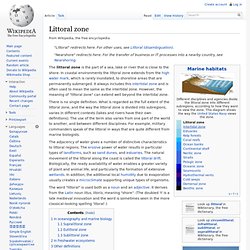
In coastal environments the littoral zone extends from the high water mark, which is rarely inundated, to shoreline areas that are permanently submerged. It always includes this intertidal zone and is often used to mean the same as the intertidal zone. However, the meaning of "littoral zone" can extend well beyond the intertidal zone. There is no single definition. What is regarded as the full extent of the littoral zone, and the way the littoral zone is divided into subregions, varies in different contexts (lakes and rivers have their own definitions). The adjacency of water gives a number of distinctive characteristics to littoral regions.
The word "littoral" is used both as a noun and an adjective. In oceanography and marine biology[edit] In oceanography and marine biology, the idea of the littoral zone is extended roughly to the edge of the continental shelf. Why you should worry about drinking water. Types of Water Filtration Systems. Bacteria, parasites, fluoride, chlorine, emerging pollutants…just a few of the reasons why you may be considering a water filtration system.
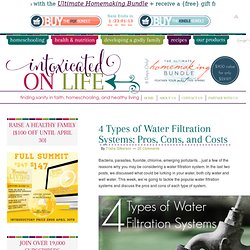
In the last two posts, we discussed what could be lurking in your water, both city water and well water. This week, we’re going to tackle the popular water filtration systems and discuss the pros and cons of each type of system. Thanks to Bulk Herb Store for underwriting this post. In addition to the pros and cons, we’ll do a price comparison.
Backpacking Water Filter Hydration Pack. With a backpacking water filter, you don’t have to worry about hauling clean drinking water.
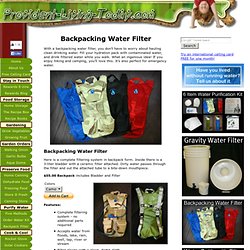
Fill your hydration pack with contaminated water, and drink filtered water while you walk. What an ingenious idea! If you enjoy hiking and camping, you’ll love this. Berkey Water Filter Systems - World Leader in Portable Water Purification. Sport Berkey™ - Berkey Sport Bottle Water Filter. Iale: Home Landscape Ecology. Upaya Naturals - Shower Filters. KDF filter media - Lenntech. M.Karnib%20et%20al. CCEWQ-03-ActivatedCarbonWtrTrt. Activated Charcoal Water Treatment Unit. Read our Home Water Treatment Instructions First Activated charcoal (activated carbon) filters have been used in homes to remove taste and odor.

Taste and odor, although undesirable, are generally not considered unhealthy. In recent years, however, activated charcoal filters have been used to remove some of the contaminants that have been discovered in water supplies. Activated charcoal is most effective at removing organic compounds such as volatile organic compounds, pesticides and benzene. It can also remove some metals, chlorine and radon. Because activated charcoal systems are limited in the types of compounds they can effectively remove, it is essential that the homeowner determine which water contaminants are present before purchasing such a system. Note that home water treatment is considered only a temporary solution. Home activated charcoal treatment systems are quite simple. Physical and chemical characteristics of the water will also affect performance. Muh-31-4-6-0703-2. What Contaminants Activated Carbon Filters Remove From Water.
HOME PAGE Customer Service Activated carbon (AC) filtration is most effective in removing organic contaminants from water.

Organic substances are composed of two basic elements, carbon and hydrogen. JSA Web Store - JIS S 3201:2010 Testing methods for household water purifiers. Home Water Purification Systems designed by ecologist James P McMahon. Clearing the Air: Chloramine Control for Indoor Swimming Pools - Drinking Water and Health Newsletter. Clearing the Air: Chloramine Control for Indoor Swimming Pools By Tom Griffiths, Ed.D.

Director of Aquatics, Penn State University President, Aquatic Safety Research Group, LLC Perhaps the most perplexing and controversial problem facing heavily used indoor pools today is chloramine production. Chloramines cause obnoxious odors as well as skin, eye, and respiratory irritation that many swimmers mistakenly attribute to chlorine itself. When chloramine levels become troublesome (0.3-0.5 parts per million (ppm)), people begin to complain.
Facts - Citizens Concerned About Chloramine (CCAC) Your one stop for all your chloramine questions. Tb-chloramine. Removing Chloramines – Pure Water Products, LLC. We offer free tech support by phone if you have a problem in installation or service. Chloramine, which consists of a mixture of chlorine and ammonia, is added to the water of many cities as a substitute for free chlorine. It is often referred to in the plural, as “chloramines,” because it can take on a number of forms according to the pH and mineral content of the water. The whole reduction discussion for chloramines can become quite complex, but the main thing you need to know is that chloramine is removed from water with essentially the same strategies that are used to remove chlorine. This means that carbon filtration is the best removal method, and, contrary to urban legends, filter carbon does indeed remove chloramine.
The problem is that it takes more carbon and more contact time to do the job. For drinking water you can consider high quality carbon units like Multipure, or double and triple units that use lots of carbon. How do you remove chloramines from tap water? - Tap Water in Aquariums FAQs. Question: How do you remove chloramines from tap water?
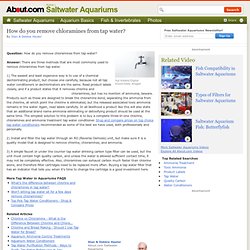
Answer: There are three methods that are most commonly used to remove chloramines from tap water. 1) The easiest and least expensive way is to use of a chemical dechlorinating product, but choose one carefully, because not all tap water conditioners or dechlorinators are the same. Read product labels closely, and if a product states that it removes chlorine and chloramines, but has no mention of ammonia, beware. Products such as these are designed to break the chloramine bond, separating the ammonia from the chlorine, at which point the chlorine is eliminated, but the released associated toxic ammonia remains in the water. Again, read labels carefully. Removing Chloramines From Water. Originally Published by A.J. deLange in Brewing Techniques, Volume 9, Number 1 As chloramination replaces chlorination of drinking water in a growing member of water districts, brewers who feel it’s a problem can no longer rely on standing boiling, or aeration to remove it.
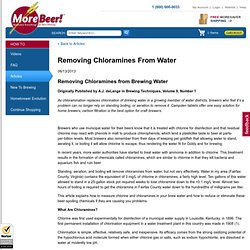
Campden tablets offer one easy solution for home brewers; carbon filtration is the best option for craft brewers. Brewers who use municipal water for their beers know that it is treated with chlorine for disinfection and that residual chlorine may react with phenols in malt to produce chlorophenols, which lend a plasticlike taste to beer at parts-per-billion levels. Removing Chloramines From Water. Microbial & Disinfection Byproducts Rules. Chloramines are disinfectants used to treat drinking water.
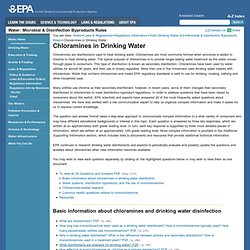
Chloramines are most commonly formed when ammonia is added to chlorine to treat drinking water. The typical purpose of chloramines is to provide longer-lasting water treatment as the water moves through pipes to consumers. This type of disinfection is known as secondary disinfection. Chloramines have been used by water utilities for almost 90 years, and their use is closely regulated. More than one in five Americans uses drinking water treated with chloramines. Many utilities use chlorine as their secondary disinfectant; however, in recent years, some of them changed their secondary disinfectant to chloramines to meet disinfection byproduct regulations.
The question and answer format takes a step-wise approach to communicate complex information to a wide variety of consumers who may have different educational backgrounds or interest in this topic. May be neuro toxic. fluoride filters use activated alumina-remove chlorine with KDFGAC. Filtre à eau japonais, filtration et dynamisation de l'eau. Naturalizer Kirameki : l'eau de source volcanique au robinet Durable : pas de cartouches à changer grâce au rétronettoyageEcologique : uniquement des constituants naturels Prix juste : importation directe sans intermédiaire Sûr : fabriqué au Japon depuis 30 ans Mars 2014 : Le nouveau modèle 2014 (photo en bas sur fond bleu) possède une capacité de filtration supérieure à l'ancien, à savoir 200 000 litres, vu son volume plus important.
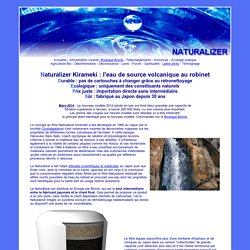
Les photos des coupes sur l'ancien modèle sont utilisées ici à titre informatif, le principe étant identique pour le nouveau modèle. Commandes sur la Boutique Biovie. Constituants du filtre Naturalizer Kirameki Références Cristaux de Masaru Emoto La première référence provient d'une méthode d'analyse globale, proche de la cristallisation sensible, qui est l'analyse des cristaux d'eau congelés, fruit des travaux de Masaru Emoto. Water Filter Guide, A Consumer Guide to Choosing Drinking Water Systems. Tenko Seki Info LinkClick. Water Filters.